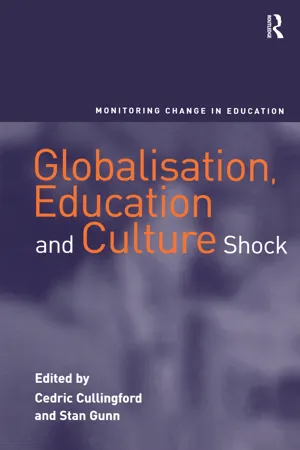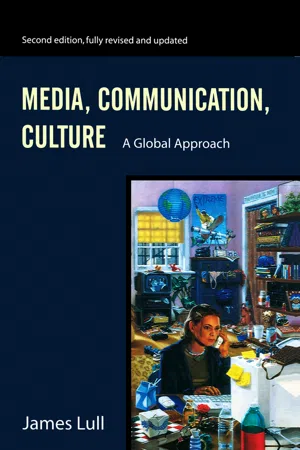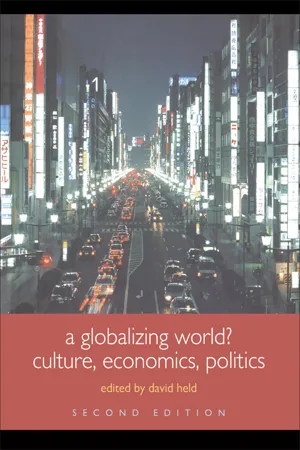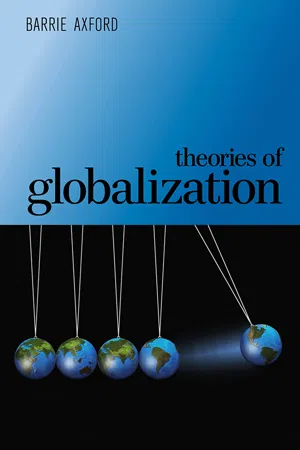Contemporary Cultural Diffusion
Contemporary cultural diffusion refers to the spread of cultural elements, such as ideas, beliefs, practices, and technologies, across different societies and regions in the modern world. This process is often facilitated by globalization, migration, trade, and communication technologies, leading to the blending and exchange of diverse cultural traditions and expressions. It is a key focus in understanding the interconnectedness of societies and the dynamics of cultural change.
5 Key excerpts on "Contemporary Cultural Diffusion"
- eBook - ePub
- Stan Gunn, Cedric Cullingford, Cedric Cullingford(Authors)
- 2017(Publication Date)
- Routledge(Publisher)
...Chapter 2 The Concepts of Globalisation and Culture Paul Oliver Discourse involving globalisation has become so pervasive in postmodern society that it easy to think of it as a disembodied process, somehow independent of the rapidly-developing society in which it evolved. To reify globalisation in this manner is to disengage it from the social processes which gave rise to the complex economic and cultural interactions which we see in contemporary life. For globalisation arose from within that particular mode of cultural organization which succeeded modernity. Moreover, the complex exchanges which are the distinctive feature of globalisation have generated new cultural variants, and continue to influence the development of cultures on a transnational basis. An important element of the thesis of this chapter is that it is less a case of globalisation influencing culture, or of cultural forms initiating innovative types of global interaction; but rather that globalisation and culture are in a symbiotic relationship. They are key elements in a dynamic equilibrium of societal transformation. The transmisson of cultural forms across time and space is not a new phenomenon. The migration of peoples, political and economic hegemonies, and the impact of key individual thinkers, have all at times influenced the dissemination of culture. But this cultural dispersion has often been slow, and been limited by geographical and political boundaries. The significance of globalisation is that it has enabled cultural transmission to take place on a scale which would not be conceivable without contemporary technological infrastructures. The sheer extent of such cultural dispersion has encouraged the view of globalized culture not exclusively as idea or concept, but as commodity...
- Nuala C. Johnson, Richard H. Schein, Jamie Winders(Authors)
- 2013(Publication Date)
- Wiley-Blackwell(Publisher)
...Although cultural geography developed historically and intellectually in relation to other areas of human geography, such as cultural ecology and social geography, it also has developed in relation to its practical and institutional contexts. Cultural geography means different things in different places and is enacted in different ways, especially between its North American and British variants (see, for example, Audrey Kobayashi’s discussion of this phenomenon in relation to geographic treatments of race in Chapter 9). Where cultural geography is performed, and where cultural-geographic research is produced, then, shapes what cultural-geographic scholarship looks like as much as does the widening array of spaces and places that cultural geographers now study. In all these ways, cultural geography, as a body of work, is as unruly as ever in its wanderings into other subdisciplines and disciplines, is as spatial as ever in the different strands of theories and writings that coexist as cultural geography in different places, and is as foundational as ever to the field of human geography in its interrogation of the relationship between the spatial and the social, landscape and cultural processes, past and present. The chapters commissioned for this new companion to cultural geography take up the difficult task of sorting through the unruliness, spatiality, and continuing centrality of contemporary cultural geography. The chapters are written by scholars who self-identify as cultural geographers and by geographers who write about cultural themes from the perspective of other subdisciplines. Thus, this companion reflects on the field of cultural geography from within and from without. While this approach might problematize the notion of a coherent subdiscipline, it also makes a claim about the continuity and relevance of cultural geography as a way of looking at the world, from the past to the future. That claim is especially salient today...
- eBook - ePub
Media, Communication, Culture
A Global Approach
- James Lull(Author)
- 2013(Publication Date)
- Polity(Publisher)
...9 Globalization and Cultural Territory Somewhere in the Middle East a half dozen young men could well be dressed in jeans, drinking Coke, listening to rap, and between their bows to Mecca, putting together a bomb to blow up an American airliner. Huntington 1996: 58 It is true that Coke, tourist T-shirts, and transistors have become universal … the things and symbols of Western culture have diffused into the daily lives of many of the world’s peoples, even if they are made in Hong Kong. Friedman 1994: 100 We are witness to an ever-increasing penetration of the mass media, uniformity in our dress, the victory of the fast food outlet; and at the same time we can also see the development of local communication, the rise of individual fashions, local produce and cuisine, so that it would sometimes seem that we are in the process of reappropriating our existence. One is drawn to this conclusion by the fact that, far from erasing the strength of our ties … technological advances sometimes even bolster them. Maffesoli 1996: 41 Mass and micro communications media today easily reach across national and cultural borders, a technological development that directly influences international political relations as it intensifies debates about cultural sovereignty. The impact of global communications has been a major policy focus of the United Nations Educational, Scientific, and Cultural Organization (UNESCO) since the early 1970s. The most common concern is that Western powers, spearheaded by American-owned transnational corporations, have monopolized world communications to such a degree that the economic well-being and cultural identity of less powerful nations have been mightily damaged. This contemporary transnational, transcultural drama – the globalization of material and cultural resources – is, according to Anthony Giddens, an inherent consequence of high modernity (1990: 63)...
- eBook - ePub
A Globalizing World?
Culture, Economics, Politics
- David Held, David Held(Authors)
- 2004(Publication Date)
- Routledge(Publisher)
...The globalization of culture? chapter 2 Hugh Mackay 1 INTRODUCTION Globalization is about the growing worldwide interconnections between societies, as we saw in Chapter 1. Culture—the focus of this chapter—is in many senses the most direct, obvious and visible way in which we experience’ these interconnections in our daily lives. It is a crucial component of globalization because it’s through culture that common understandings are developed, so culture is central to connections between places and nations. Across the breadth of everyday activities there is a considerable body of evidence to suggest that our cultural traits, practices and goods—the assemblage we use to construct meaning symbolically—are increasingly global. Indeed, whatever globalization has been achieved—to the extent that it has—can be seen as a result of the growing significance of the symbolic, of the power of the cultural. Although the globalization of culture seems in some ways obvious in our daily lives, it is not an entirely straightforward matter. Culture is a complicated and pervasive phenomenon, taking many forms. This chapter focuses on the media and, in particular, the popular cultural form of television. In the contemporary era, culture has become increasingly mediated; and television-viewing is a major leisure activity in the Western world. The chapter explores the various positions in the globalization debate which have been outlined in Chapter 1. It starts, in Section 2, with the arguments of those who see the decline of national cultures and the rise to the fore of global culture flows. Broadly speaking, these globalists fall into two categories. On the one hand are those who see the phenomenon in a positive way—such as those who argue that, with new communication technologies, we are moving towards a ‘global village’ in which communication and community can be freed from their physical or geographical constraints and a greater diversity of voices can be heard...
- eBook - ePub
- Barrie Axford(Author)
- 2014(Publication Date)
- Polity(Publisher)
...The idea of multicultural fusion or hybridization suggests widespread intermingling across geographical scales and across cultures. In one guise this involves the usual array of cosmopolitan mixes – fusion food, ethnicizing of fashion and so-called world music – while in another it discerns and may applaud the ‘repertoires of possibility’ available to people through routine use of Web technologies and formats to promote social interaction and bespoke identities (Bourdieu, 1991, 26; Axford and Huggins, 2010). Inglehart and Norris are suitably cautious about the effects of global communications and about media effects more generally, while suggesting that as interconnection between societies becomes more extensive and intensive its cultural impact is very likely to grow. Mainly, they are wary of attributing too many cultural consequences to cosmopolitan media because cultural firewalls (their term) exist which ‘preserve the imprint of distinctive national cultures, especially in poorer societies’ (2009, 147). In their estimation, the enduring weight of distinctive historical conditions and traditions vitiates the power of border-crossing technologies and media formats, even where, as in the case of Google, they can appear as modal. This judgement may be affected by the authors’ apparent willingness to endorse the old antinomies of local/global and homogeneity/heterogeneity which reinforce an either/or view of the world, rather than entertain the possibility of ‘many globalizations’ (Berger and Huntington, 2002), ‘third cultures’ which are neither local nor global (Featherstone, 1990), the idea of a heterogeneous yet singular world culture, and the ‘complex relationalities’ revealed in the study of what John Urry labels ‘global fluids’ like the internet (2003; 2005; see also Ong and Collier, 2005)...




